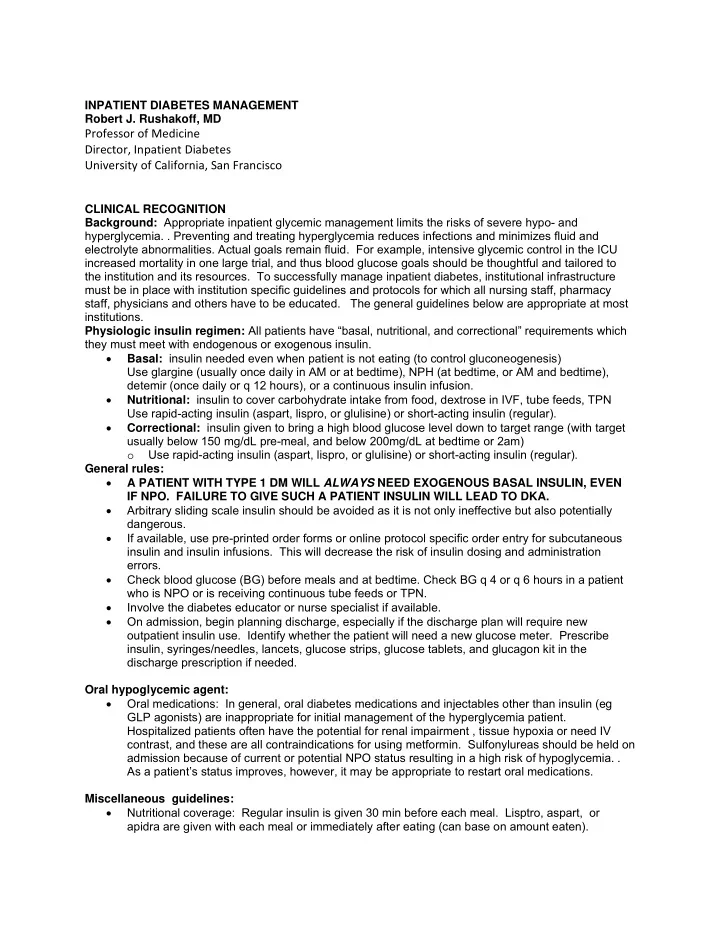

INPATIENT DIABETES MANAGEMENT Robert J. Rushakoff, MD Professor of Medicine Director, Inpatient Diabetes University of California, San Francisco CLINICAL RECOGNITION Background: Appropriate inpatient glycemic management limits the risks of severe hypo- and hyperglycemia. . Preventing and treating hyperglycemia reduces infections and minimizes fluid and electrolyte abnormalities. Actual goals remain fluid. For example, intensive glycemic control in the ICU increased mortality in one large trial, and thus blood glucose goals should be thoughtful and tailored to the institution and its resources. To successfully manage inpatient diabetes, institutional infrastructure must be in place with institution specific guidelines and protocols for which all nursing staff, pharmacy staff, physicians and others have to be educated. The general guidelines below are appropriate at most institutions. Physiologic insulin regimen: All patients have “basal, nutritional, and correctional” requirements which they must meet with endogenous or exogenous insulin. Basal: insulin needed even when patient is not eating (to control gluconeogenesis) Use glargine (usually once daily in AM or at bedtime), NPH (at bedtime, or AM and bedtime), detemir (once daily or q 12 hours), or a continuous insulin infusion. Nutritional: insulin to cover carbohydrate intake from food, dextrose in IVF, tube feeds, TPN Use rapid-acting insulin (aspart, lispro, or glulisine) or short-acting insulin (regular). Correctional: insulin given to bring a high blood glucose level down to target range (with target usually below 150 mg/dL pre-meal, and below 200mg/dL at bedtime or 2am) o Use rapid-acting insulin (aspart, lispro, or glulisine) or short-acting insulin (regular). General rules: A PATIENT WITH TYPE 1 DM WILL ALWAYS NEED EXOGENOUS BASAL INSULIN, EVEN IF NPO. FAILURE TO GIVE SUCH A PATIENT INSULIN WILL LEAD TO DKA. Arbitrary sliding scale insulin should be avoided as it is not only ineffective but also potentially dangerous. If available, use pre-printed order forms or online protocol specific order entry for subcutaneous insulin and insulin infusions. This will decrease the risk of insulin dosing and administration errors. Check blood glucose (BG) before meals and at bedtime. Check BG q 4 or q 6 hours in a patient who is NPO or is receiving continuous tube feeds or TPN. Involve the diabetes educator or nurse specialist if available. On admission, begin planning discharge, especially if the discharge plan will require new outpatient insulin use. Identify whether the patient will need a new glucose meter. Prescribe insulin, syringes/needles, lancets, glucose strips, glucose tablets, and glucagon kit in the discharge prescription if needed. Oral hypoglycemic agent: Oral medications: In general, oral diabetes medications and injectables other than insulin (eg GLP agonists) are inappropriate for initial management of the hyperglycemia patient. Hospitalized patients often have the potential for renal impairment , tissue hypoxia or need IV contrast, and these are all contraindications for using metformin. Sulfonylureas should be held on admission because of current or potential NPO status resulting in a high risk of hypoglycemia. . As a patient’s status improves, however, it may be appropriate to restart oral medications. Miscellaneous guidelines: Nutritional coverage: Regular insulin is given 30 min before each meal. Lisptro, aspart, or apidra are given with each meal or immediately after eating (can base on amount eaten).
Infection and glucocorticoids increase insulin needs; renal insufficiency decreases insulin needs. Total daily dose of insulin needed: Type 1 patients require approximately 0.4 units/kg/day; type 2 patients vary in their insulin resistance and may require from 0.5 to 2 units/kg/day. THERAPY Insulin Regimens The guidelines below assist with initial determination and subsequent adjustment of insulin doses. Insulin doses must be reevaluated on a daily basis, and orders should be rewritten in order to achieve goals and to adapt to the patients’ changing clinical situation. 1. Insulin regimen for a patient controlled only with diet at home, but needing insulin in hospital: Day 1: Order a correctional sliding scale for before meals and bedtime (with lispro, aspart, apidra or regular) based on BMI – see Table 1. Day 2: If BG pre-meals are >150 mg/dL, add nutritional insulin (with aspart or regular) based on appetite). Also, if AM fasting BG is >150 mg/dL, add bedtime basal insulin (with glargine, detemir or NPH) dosed 0.1-0.2 unit/kg. Day 3: Adjust insulin doses based on BG pattern: Increase or decrease basal insulin based on AM fasting BG, and adjust nutritional insulin based on pre-meal BG levels (see below for details). Table 1: Correctional insulin (aspart or regular) BG Pre-meal: Pre-meal: Pre-meal: Bedtime (mg/ Sensitive (BMI <25 Average (BMI 25-30 Resistant (BMI and 2 a.m. dL) or <50 units/d) or 50-90 units/d) >30 or >90 units/d) 131-150 0 units 1 unit 2 units 0 units 151-200 1 unit 2 units 3 units 0 units 201-250 2 units 4 units 6 units 1 unit 251-300 3 units 6 units 9 units 2 units 301-350 4 units 8 units 12 units 3 units 351-400 5 units 10 units 15 units 3 units >400 6 untis 12 units 18 units 3 units 2. Insulin regimen for a patient on oral agent(s) at home but requiring insulin in hospital because of hyperglycemia or contraindications to the oral agent(s): Day 1: Start nutritional insulin (aspart or regular) based on appetite – generally about 0.1-0.2 units per kg, divided between the three meals for the day. Also, order a correctional sliding scale (aspart or regular) based on BMI – see Table 1. Day 2: If AM fasting BG is >150 mg/dL, add bedtime basal (glargine, levemir or NPH) dose of 0.1-0.2 units/kg. Day 3: Adjust insulin doses based on BG pattern: Increase or decrease basal insulin based on AM fasting BG, and adjust nutritional insulin based on pre-meal BG levels (see below for details). 3. Insulin regimen for a patient on insulin at home: If possible, consider home BG control, appetite, renal function, and risk for hypoglycemia
Recommend
More recommend